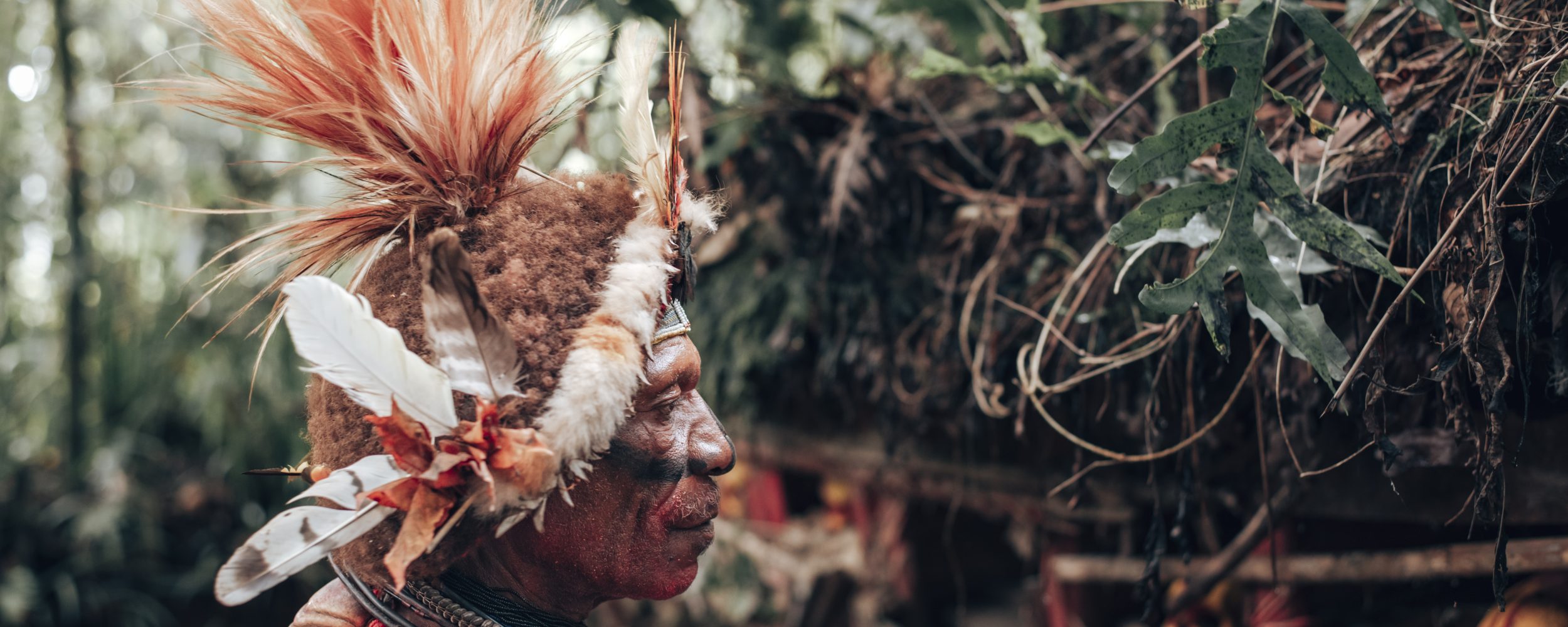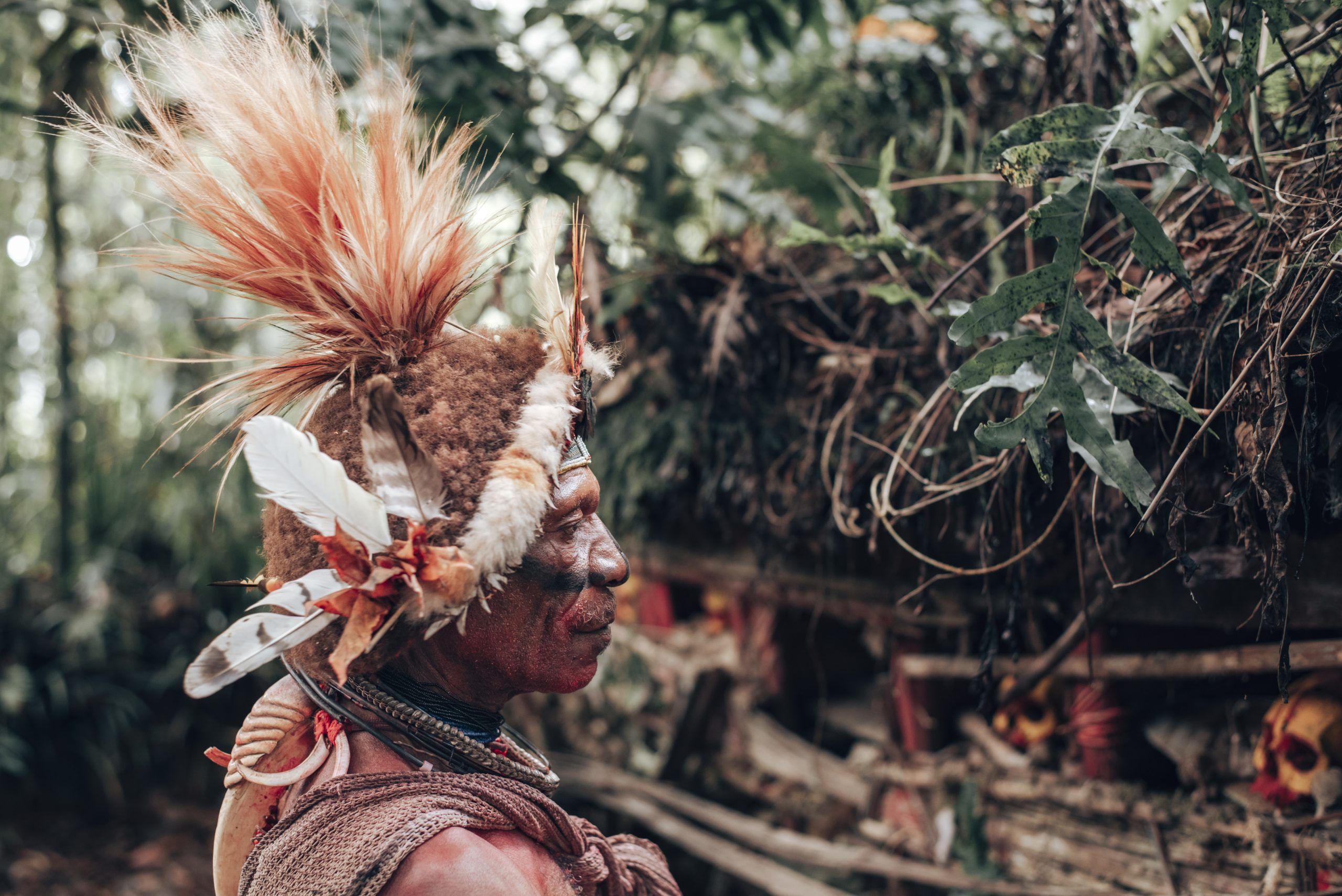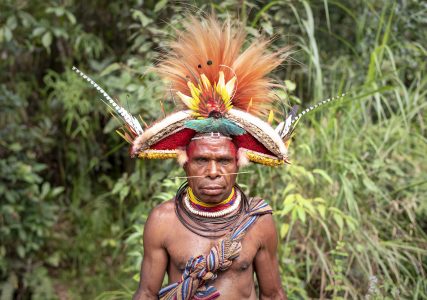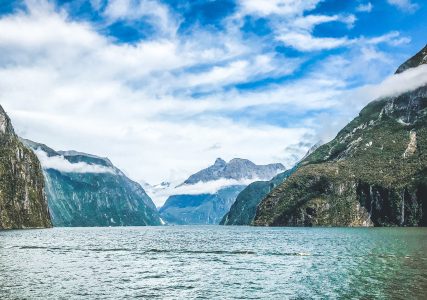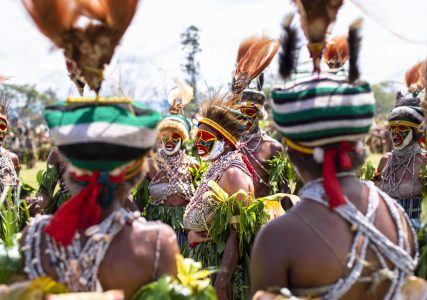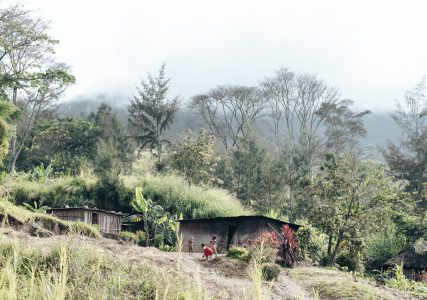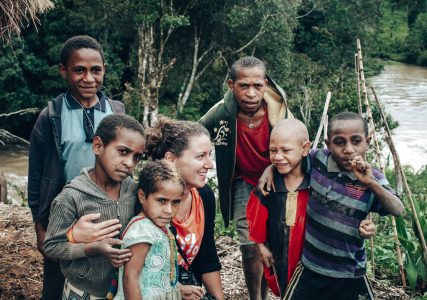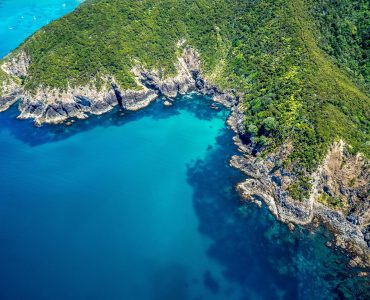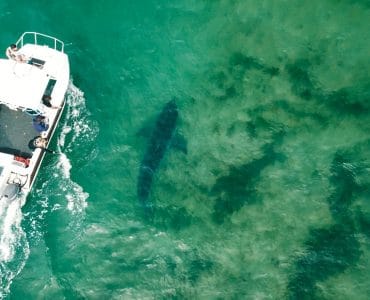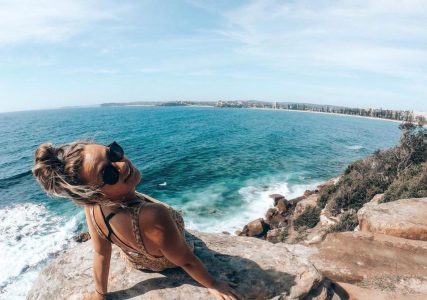The red and yellow skins and high wigs should instill fear in us. The sticks through the nose should make us shiver and the hard beats on the drums make our hearts skip a beat. But nothing is less true. The equipment of the Huli Wigmen is what has fascinated me for years. They are the reason why we are in the red negative travel advisory area.
In this blog we share a little more about the Huli Wigmen, perhaps the most famous and frightening tribe of Papua New Guinea.
Also read: Information and first introduction to Papua New Guinea
Also read: The (too) crazy adventures of Milene & Yuri
The Huli Wigmen
Who are the Huli Wigmen and where do they live?
The tribe also referred to as Huli is an indigenous people living in the districts of Tari, Koroba, Margaraima and Komo. These districts form the Southern Highlands of Papua New Guinea† The Huli have lived in this area for over a thousand years, and the population is currently estimated to be around 100,000. They speak Huli and Tok Pisin, but some can also speak some words of English.
The Huli are known for their habit of painting their faces red & yellow and wearing headdresses made with feathers from the bird of paradise† Incidentally, they are not the only tribe in this, but more about that in a later blog.
The wigs of the Huli Wigmen
The clothes, colors and headdresses are complemented by a dramatic wig worn only by men. There are several wigs and these are made from their own hair and the process takes several months to years. A common wig takes about one year to make. When a boy grows up, he starts making his wig. While growing his hair, the boy undergoes a rigorous journey, complete with restricted diet, taboos and special magic.
His hair is regularly wetted with ritual water until it has reached the right length to be formed by a circular band of bamboo. After about a year, the wig is finished and cut off.
Another wig that is often worn is a special one (see the photo below), making this takes about 2 to 3 years. Then it is decorated with feathers, wings and heads of exotic birds and some are colored with red ocher.
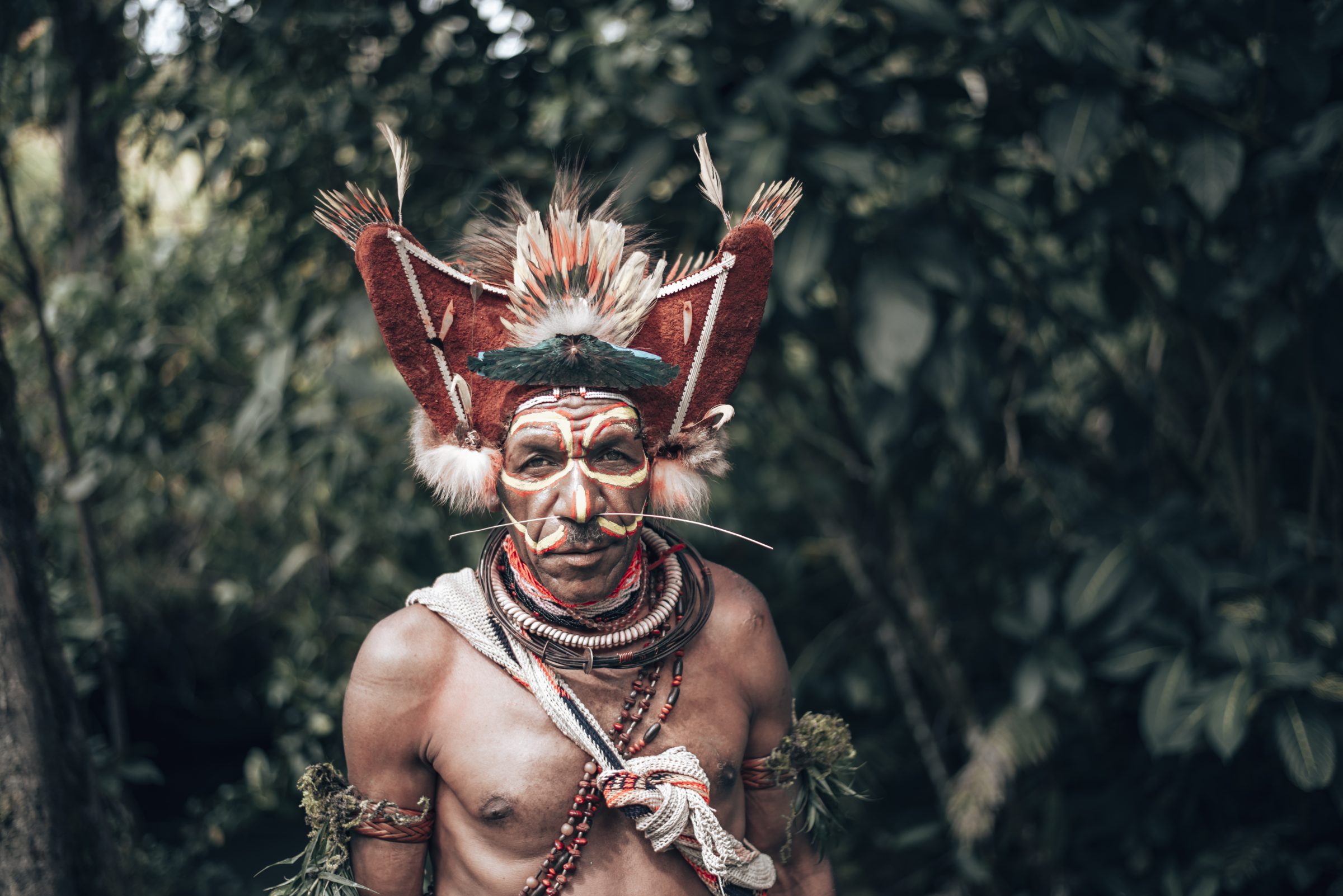
Staying with the Huli Wigmen in Papua New Guinea
The first night in Tari
I didn't sleep well. The mattress should not bear the name. It's so thin, with a hard wooden bed underneath that only allowed me to lie on my back. The pillow smells like the many people who have used it before me and the beetles outside kept on howling. I also heard a lot of mice walking over our roof and Yuri had to go to the toilet a few times.
So we are a bit tired when we are served delicious scrambled egg for breakfast. We arrived at Lukwanda lodge yesterday. It was dark and wet when we arrived. It's still wet but oh how green it is here. And what birds I heard this morning. The lodge is very basic but it is fine. We will have to make do with little these days because our luggage is still in London thanks to British Airways. Who then makes little effort to get our luggage here in Papua New Guinea. But we are now in Tari and the chance that the luggage will be brought here is nil.
We quickly throw in a cup of tea before we set off. We don't really know where to go, but we do know that we are going to eat Mumu, a local delicacy. At least, that's what we're assuming.
Introduction to the mud trails
The trail to today's village starts near the lodge. Because there is a war going on between two families, we can't go too far into the wilderness because we might run into people we don't want to meet. So we stay close to home, but even that makes for an adventure.
And that adventure begins with our introduction to the mud trails of Papua New Guinea. We slide down a kind of hill before balancing on a thin tree trunk, we have to cross a large river. Then we climb up a mud path to walk through fields. We end up at a hut on a hill overlooking the Tari River. A large river where the water has risen considerably due to the amount of rain in recent days. We always bring rain with us so it will probably not diminish in the coming days.
Actually we would cross the river to eat Mumu in the village on the other side. But due to the amount of water and strong current in the river, we decide to make the Mumu at this house. No problem for us. It's nice and the owners of the land take us along and tell us proudly about their land.
Visiting a Huli Wigmen family
The piece of land belongs to two brothers. Their father, who says he is 120, is now enjoying his 'retirement'. A mother is no more. The two brothers are owners, but the sisters, from another mother, work on the land. Along with some pigs. The sister, Ruth, who works here now tells us, hands and feet, what she does.
English is not spoken here so we have to rely on sign language. And that's fine. I understand that they grow sweet potatoes and broccoli, that the pigs help to turn the land and that they are happy to have us here.
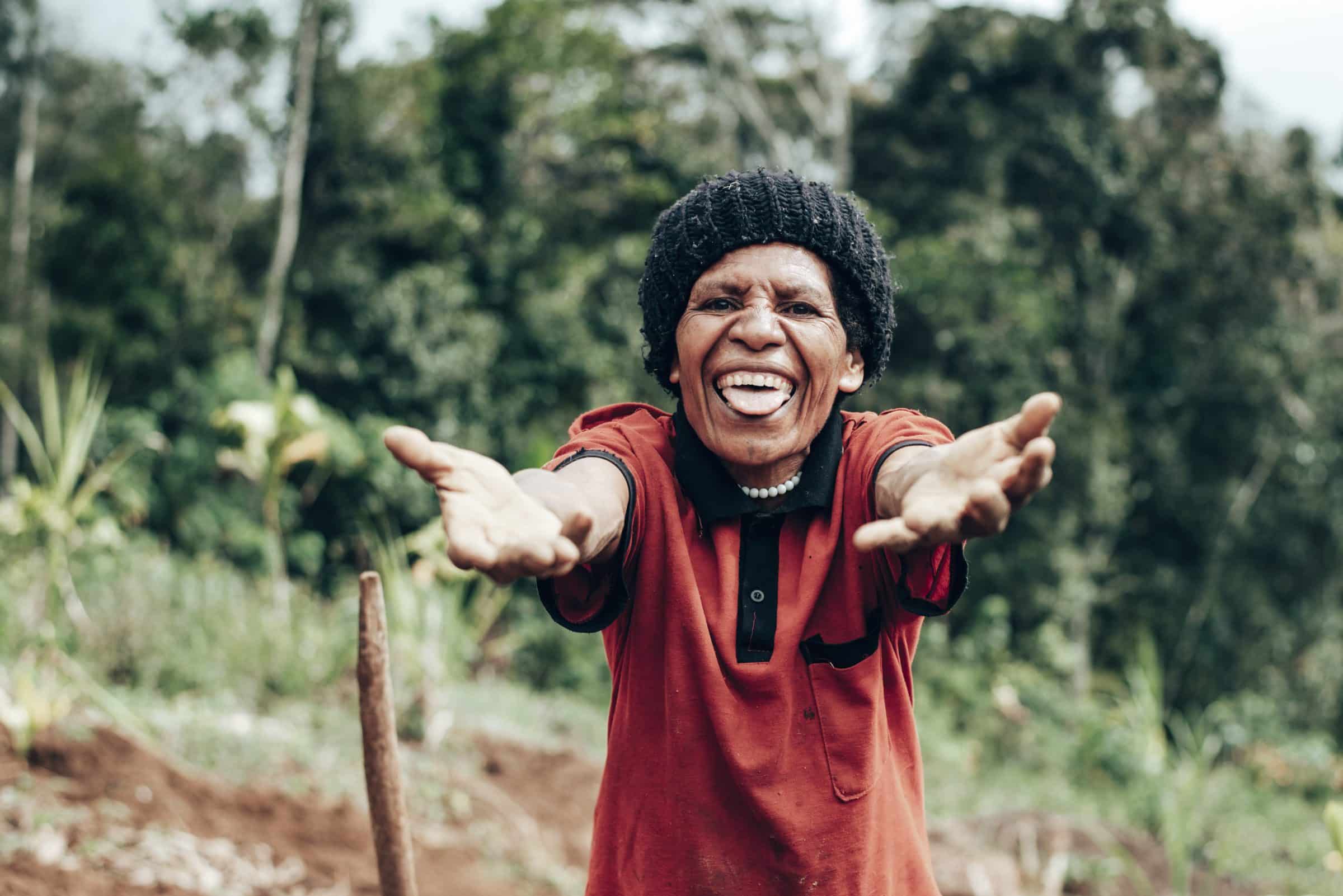
After the small tour we go back to the cottage on the hill. Here we are going to make the Mumu. A typical dish from Papua New Guinea, and something they are very proud of. First, they heat stones on a fire. Then they dig a hole in the ground. In the meantime, a chicken is killed, vegetables and fruits are cut. By the way, they don't call killing an animal "slaughter" here. “That is so Western”, Thomas explains to us. Here in Papua New Guinea they just call it killing because that's what it is in the end.
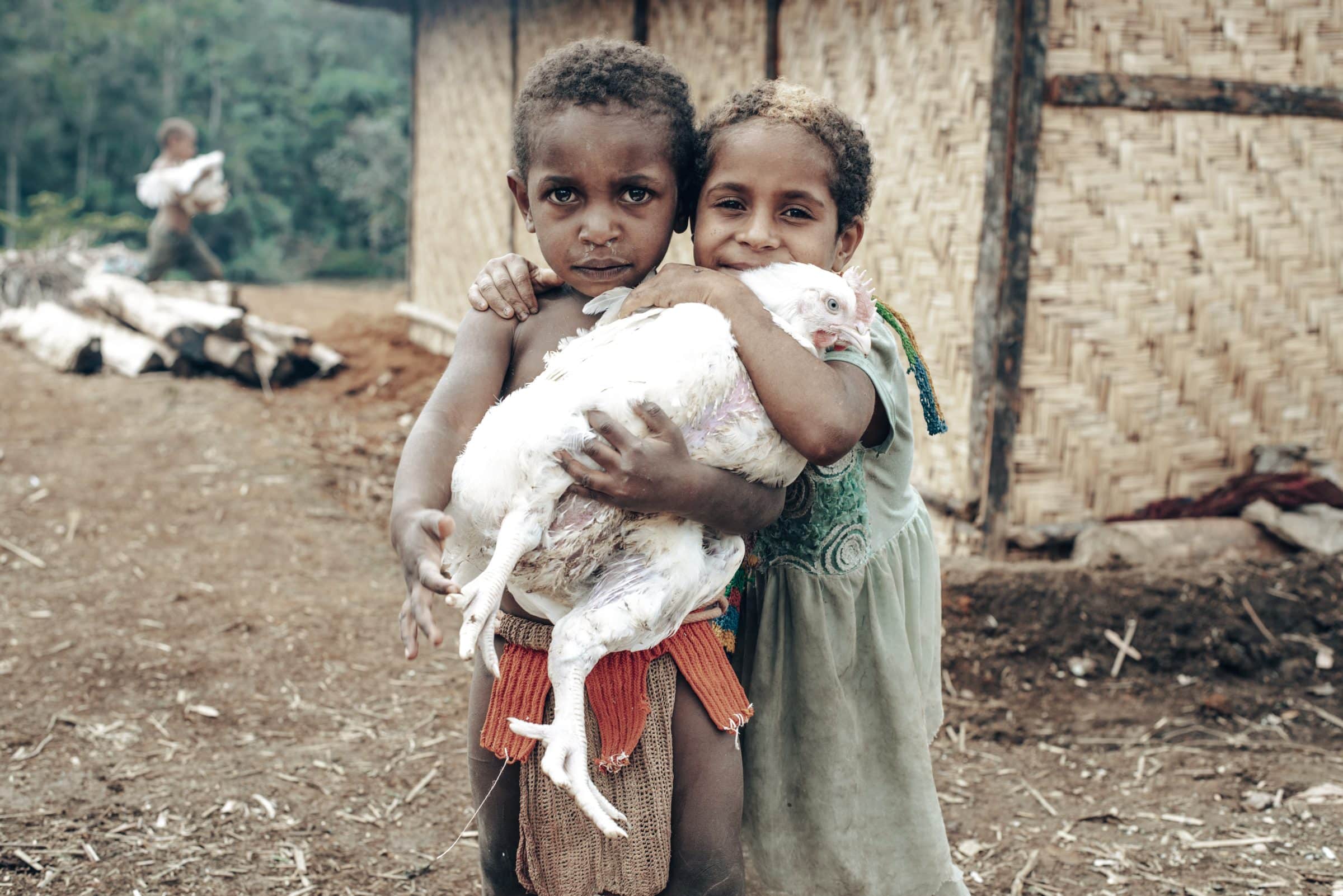
The hole in the ground is first filled with the heated stones, on top of which are banana leaves in which the food is placed. The banana leaves are also placed on top to protect the food well, followed by more hot stones. To close it properly, the soil is shoveled on top of the stones, and the food stays there for more than 1,5 hours.
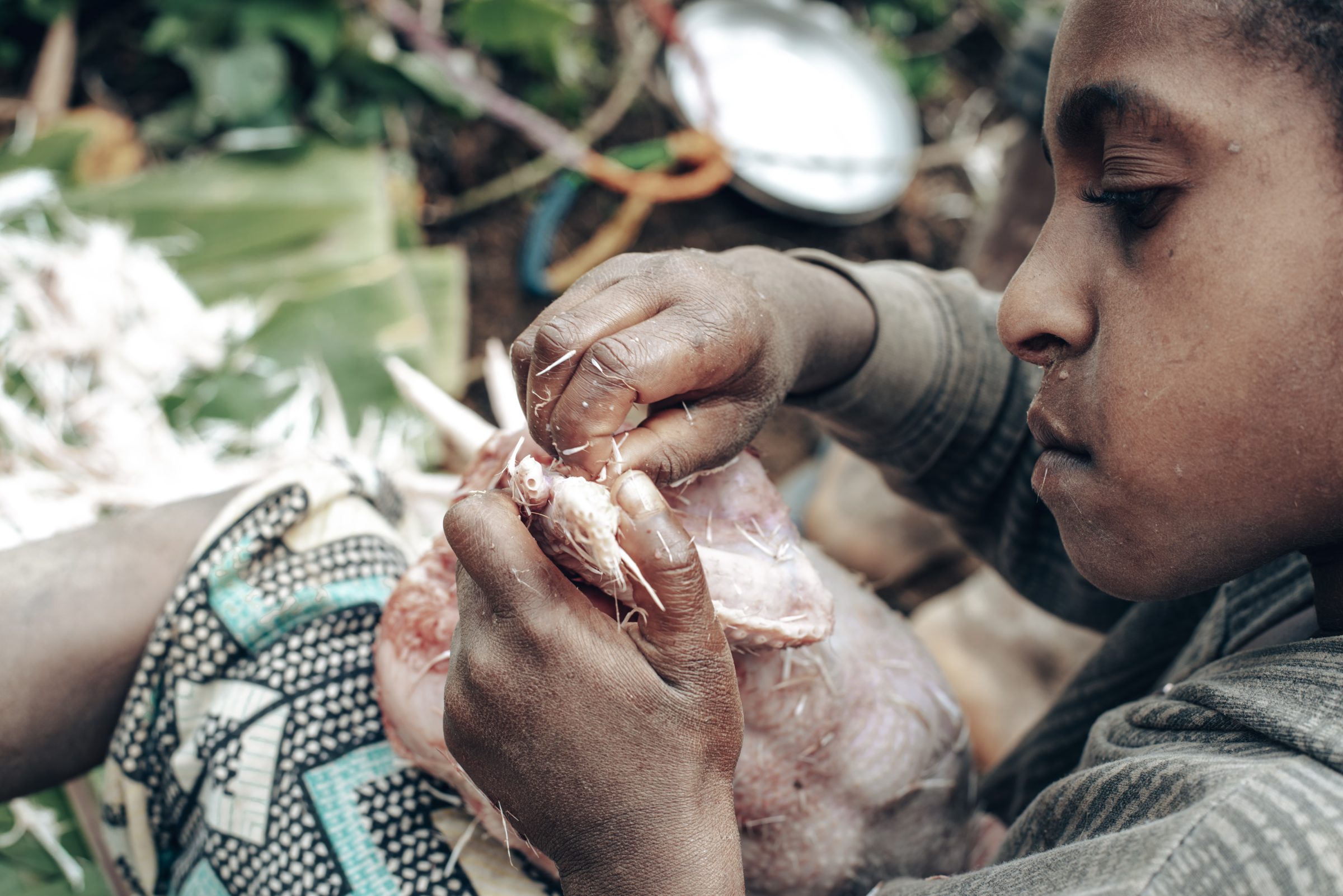
Family arguing with machete in hand
With us a little longer because just after preparing the Mumu, a small disagreement arose between the family members. At least it starts small, with some yelling and screaming. But soon, much to my delight, a machete is brought in. There are also sticks and the family members start to beat each other fairly hard. The machete is mainly used as a threat, but it still looks dangerous. I am reassured several times with “don't worry, family problems” and big smiles from everyone who is not part of the family. Thomas tries to calm it down a number of times, to no avail. I just keep a safe distance because even though they won't attack me, waving the machetes doesn't look very safe. After all, an accident is just around the corner.
It is an explosive people and that shows how this quarrel suddenly started. One minute we're all making Mumu and the next we're swinging machetes. Of course, this also concerns pieces of land. One has more than the other and jealousy plays a major role.
And just as suddenly as it began, so suddenly it ends. The Mumu is ready and it would be a shame to waste the vegetables and two chickens in a pointless fight. So soon we are all enjoying the Mumu again. So no war this time.
The banana that went in is bone-dry, the pawpaw (kind of papaya) is delicious, the sweet potato is also fantastic and the chicken is just a bit too dry but reasonably doable. We also eat the meat from the legs of the chicken which surprisingly tastes quite good.
Meeting the Huli Wigmen
After dinner it is time for the fortune teller. As previously written, we are in the area of the Huli Wigmen. A tribe that I have wanted to see since 2005 when a now ex-colleague of mine went to Papua New Guinea. And now that we're here, we're finally going to meet the Huli Wigmen fortune teller. The Huli are the largest tribe in the country and so are known for the wigs they make from their own hair.
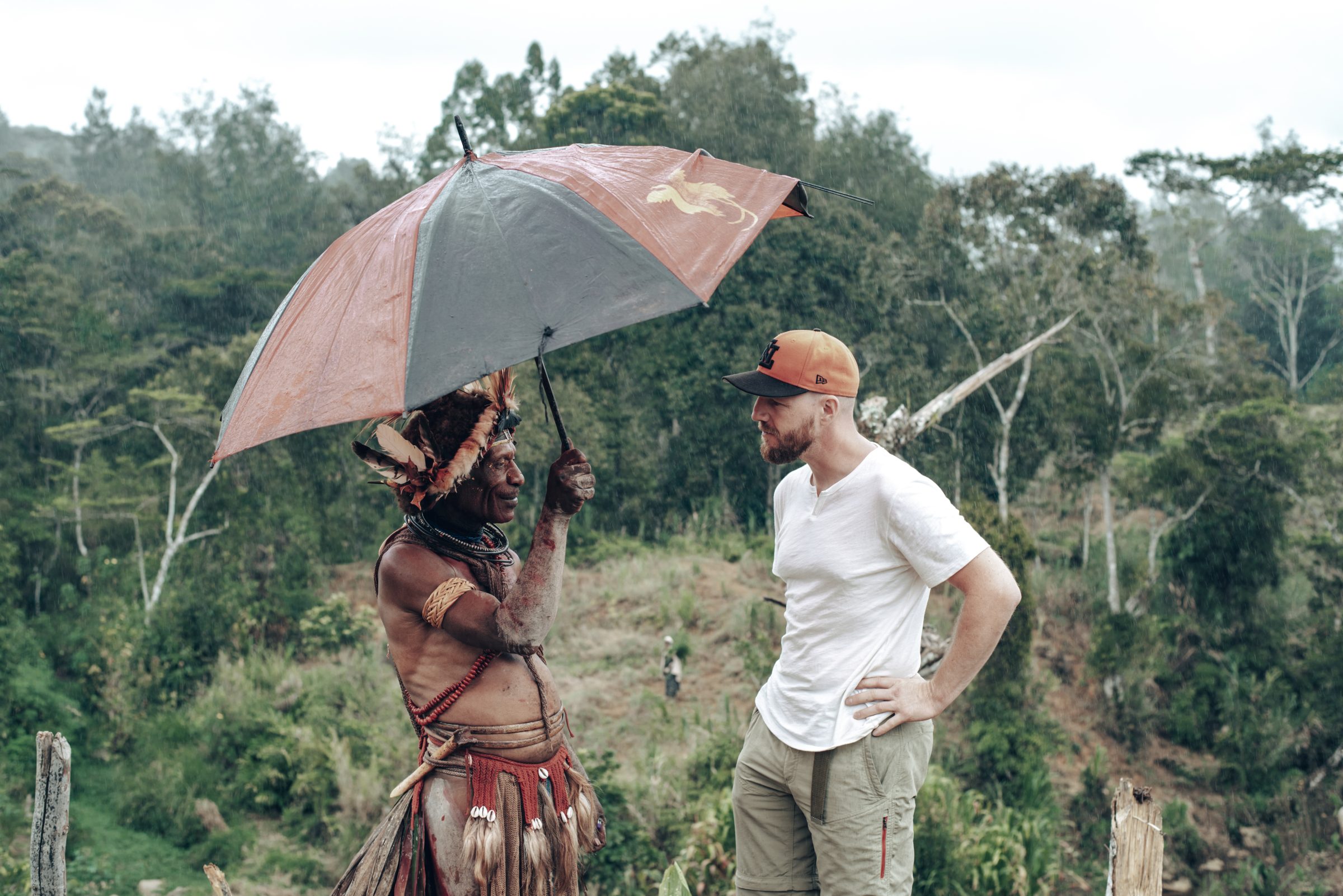
In addition to wigs, they color their faces on special occasions with bright yellow clay (this is called ambua) and is seen as sacred. Their bodies make them ocher red. When they dance, during the sing-sing, they do a bird dance. Not to be confused with the terrible bird dance we are in The Netherlands know. With this bird dance they imitate the bird of paradise.
The Huli also do fortune telling. In this region there is one fortune teller left and we are going to meet him. His name is Erebo and he is decked out in his finest Huli costume. Before we can enter the sanctuary, the ancestors must first be awakened. That happens in less than a minute. We, that is, me as a woman, also have to be approved. Thomas says that will be fine, after all, I am a tourist and different rules apply to tourists.
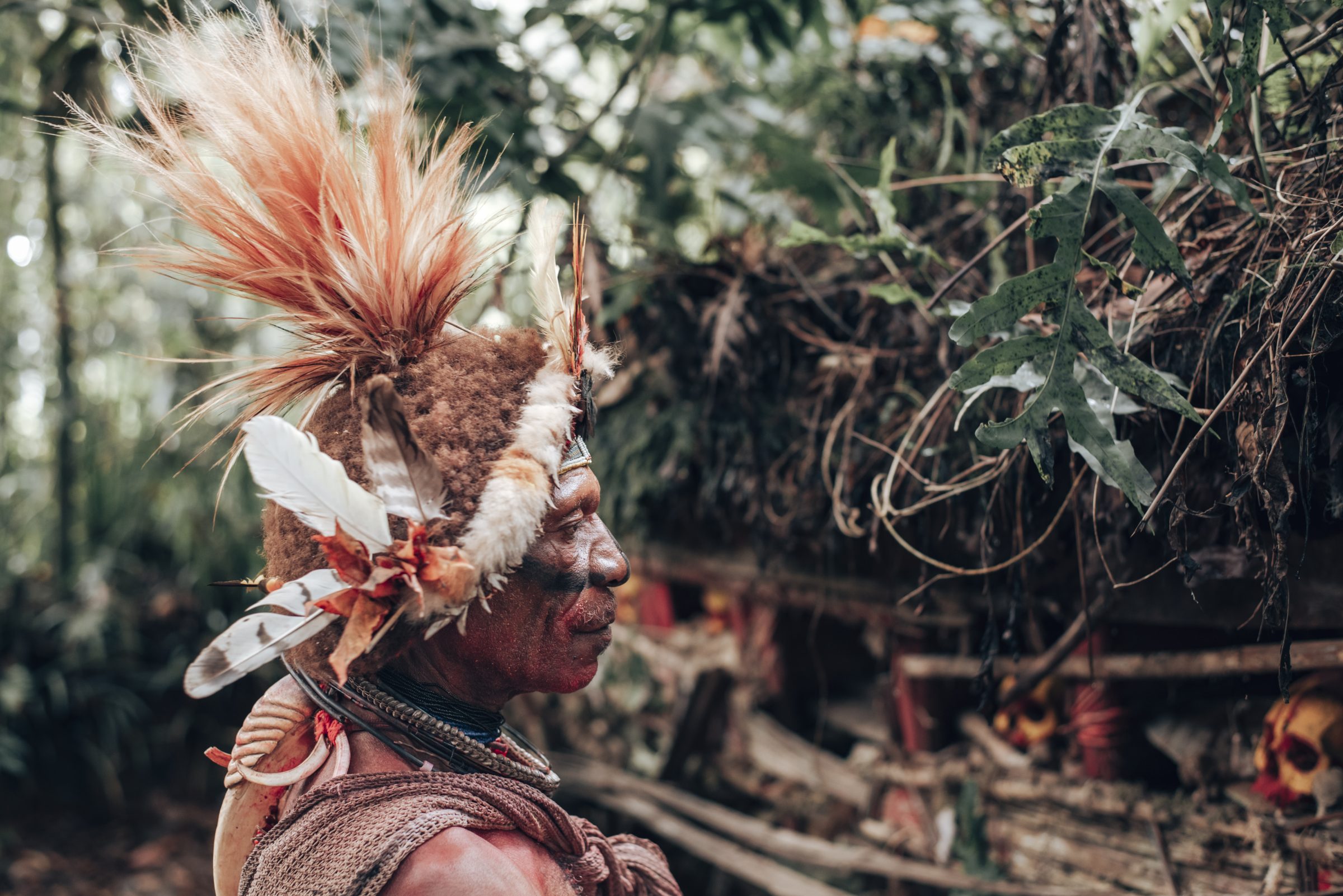
The fortune teller
We walk through a piece of forest to eventually arrive at a small clearing between all kinds of beautiful green trees and plants. In this clearing, a structure of wooden posts and planks stands on top of each other. I don't know what it is supposed to represent, but when we walk around it we suddenly see a number of skulls painted yellow in a row. Those are the ancestors Thomas tells us. Nine generations of skulls lie ahead of us.
Erebo has now started the ceremony. It is a kind of song with words that cannot be understood. Thomas occasionally encourages him to continue singing. And when he stops, it's time for Yuri to ask a question. He wants to know what the future of his love life is like. Erebo then asks the question to his ancestors. Erebo indicates that the person with whom Yuri grows old may be traveling with him. Maybe she's here. What do you think?
We say goodbye to Erebo and go back to the lodge. To rest as our next adventure includes a long hike deeper into the jungle. And since we still wear the same clothes as during our plane and car trip here, it is also nice to hang them out for a while.
Join us on an adventure
Follow us on for the wildest adventures, compelling stories and (too) crazy places www.mygrations.nl en Instagram† At the moment we are driving a Volkswagen van to China on the ancient trade route; The Silk Road.
Also read: Information and first introduction to Papua New Guinea
Also read: The (too) crazy adventures of Milene & Yuri


